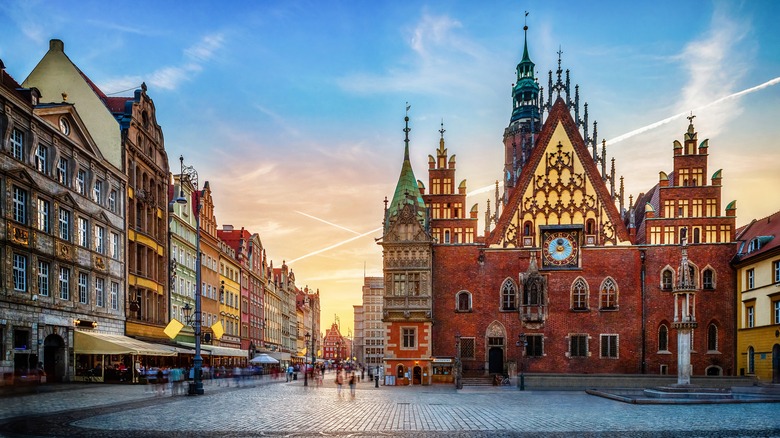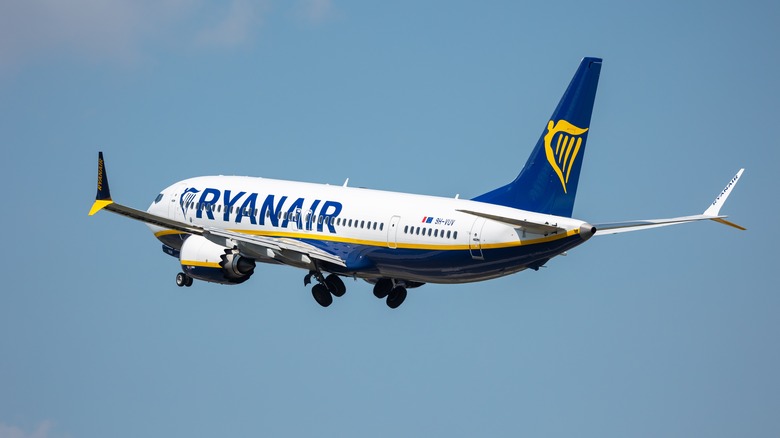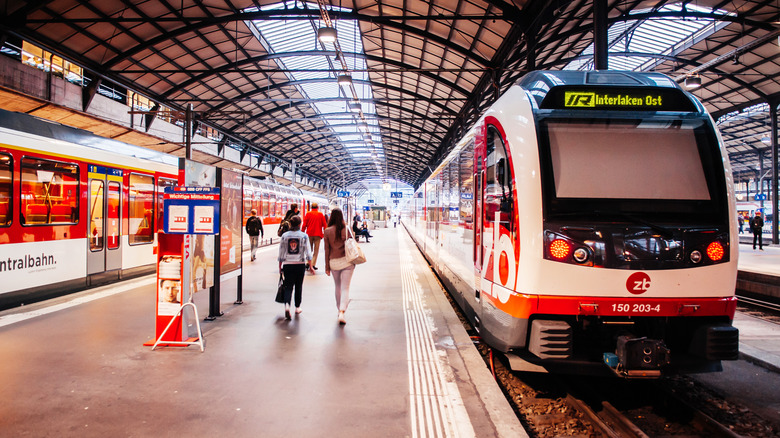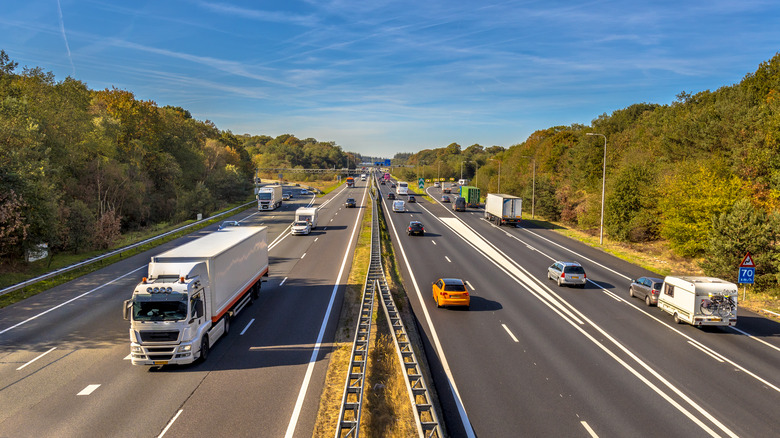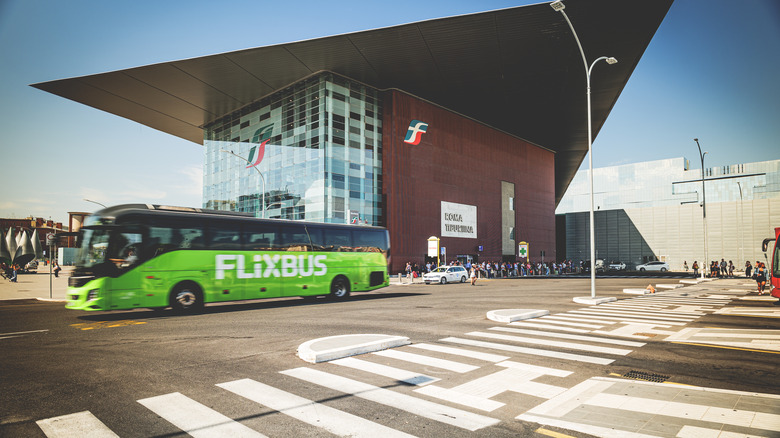Planes, Trains, Or Automobiles: What's The Best Way To Country-Hop Throughout Europe?
Europe is the easiest continent for quick and efficient country-hopping. You have major cities like Paris and London a mere two hours apart. There are landlocked countries such as San Marino and the Vatican located within Italy. And Eastern Europe's tiny nations are an easy bus, train, or car ride away to go from one to the next. Country-hopping is simply part of the experience when traveling throughout Europe.
If you choose to visit Europe, and you want to see more than one nation while there, you might be wondering what the best way to country-hop is. Should you take advantage of the super efficient European trains? Busses are often a cheap way to travel, but how reliable are they when it comes to country-hopping? What about island nations such as Malta and Cyprus; should you take a ferry or a seaplane? Speaking of planes, why not just fly when country-hopping around Europe? Do you need an international driver's license to rent a car, and how difficult is it to cross over borders if you're doing a road trip?
These are all valid questions, and while each mode of transportation has its perks, there are certain scenarios where one might outrank another. We are here to break it all down for you, whether it's plane, train, bus, automobile, ferry, organized day tours, and even walking.
Making the case for planes
Let's start with the most obvious way to travel: flying. While flying makes sense in most cases, country-hopping in Europe is not always one of them.
Europe is filled with budget airlines with frequent flights (Ryanair, Wizz Air, easyJet, and more). While fares might appear to be on the cheap side (sometimes under $10 for a flight), budget airlines are notorious for charging for every little thing imaginable, including, but not limited to, printing a boarding pass at the airport, seat selection, and baggage fees, oftentimes even for a carry-on. These extra costs are worth taking into consideration if you're taking an $8 flight simply because it's "only $8."
That said, flights do sometimes make more sense when traveling in Europe. For example, if you're traveling from Lisbon to Budapest, or any western European country to one further east, flying probably makes the most sense. Regardless, you'll want to consider the amount of time it takes to get to the airport (most major airports in Europe are far from the city center), the additional hours you'll spend at the airport waiting for the flight, and how long it will take you to arrive at your destination when you land. With that, you can then weigh your options.
Another factor to consider is the environmental effect. Flying is the least environmentally-friendly option on this list, and with Europe having so many other reliable modes of transportation, it is seldom the best way to go.
Making the case for trains
Trains in Europe, generally speaking, tend to be scenic, fast, and efficient. Schedules are frequent, they are seldom delayed (though, Italy is the exception), and train stations are often more centrally located than airports.
When visiting Schengen nations, trains can pass through countries without any need for passport control because of EU regulations, saving ample time. If you plan to be in Europe for at least a week and hope to visit at least two cities (or nations), purchasing a Eurail pass is well worth it. With a Eurail pass, you can simply go on the app to see the schedule of where you'd like to go, and you can often book your train up to the last minute (though, in high season like summer, it's advised to book ahead).
Train rides in Europe are often quite scenic. Some of the most beautiful are the train ride that inspired the Hogwarts Express and the ride from Trento, Italy through the Alps to Innsbruck, Austria.
Most trains in Europe have Wi-Fi, many of them are high-speed (for example, Lyon to Paris would be a five-hour drive, but on the high-speed train, it's under two hours), there are often snacks and drinks available onboard, and seats are comfortable. There is a reason so many, including us, rave about the trains in Europe; it's one of the best ways to travel.
Making the case for automobiles
Are you down for an epic road trip? If so, renting a car might be the way to go. Aside from road trips being a fun adventure, the flexibility of being able to come and go as you please is a great advantage. Who wants to punch a clock while on vacation?
There are a few factors to consider before Euro country-hopping via automobile, however. First, you'll want to double-check that your current license complies with every country you plan to visit. Do you need an international driver's license for any of your potential destinations? You'll also want to ensure you know the traffic rules — most importantly, which side of the road to drive on. For example, in the United Kingdom, get ready to drive on the left side as opposed to the right (which is true for the majority of European nations). Most cars in Europe are not automatic, and only a small number of automatic vehicles will be available, so you should be prepared to drive a stick shift. Another downfall is traffic and potentially long waits at borders.
Despite these concerns, driving is an efficient way to travel throughout Europe, and is generally affordable, especially if you use services like Europcar and Booking.com. Renting a car in Europe is so reliable that, at one point, the Guinness World Record was broken for Most Countries Visited in a Day by three men who drove to 19 European countries in a single day.
Making the case for busses
If trains are too expensive or not readily available in your destination, you might want to consider taking a bus. Busses are a great option, especially if you're traveling to smaller towns as opposed to large, major cities. Busses are also an affordable and reliable way to country-hop through Eastern Europe.
Busses really come in handy when trying to visit some of those smaller, landlocked nations. Places like San Marino, Liechtenstein, and Andorra are often best accessed via bus. For example, there are only four train stations in Liechtenstein, and schedules are fairly inconsistent. Instead of relying solely on trains if you want to visit Liechtenstein from Austria, for example, you would want to take a train to Feldkirch, Austria, and then hop on a bus from the station to get across the Liechtenstein border. Another example is traveling to San Marino, where one of the most popular ways to travel is via Bonelli bus from Rimini.
Traveling via bus is often the most affordable option. For example, busses in Luxembourg are completely free. When it comes to country-hopping, FlixBus offers affordable fares throughout all of Europe, but it especially comes in handy in Eastern Europe where train schedules might not be as frequent. Busses are also great for visiting smaller towns as opposed to large cities. A great way to compare bus and train schedules is by utilizing sites like Omio.
Other Options ... And In Conclusion
Any of these travel methods are viable for country-hopping through Europe, and it all depends on your specific plans and goals. Other ways to country-hop are by taking a ferry (example routes would be from Sicily to Malta, Southern Italy to Albania, etc.), and even walking into a country for added adventure (examples: Italy to the Vatican, France to Monaco, Austria to Liechtenstein, Liechtenstein to Switzerland). It all depends on your comfort level and the route you plan to take.
With that being said, if there is an overall winner for the most convenient way to travel around Europe, our vote is trains. To reiterate, trains in Europe run frequently, often have Wifi and a bar/cafe available for purchasing snacks, and the majority of them are high-speed. Our vote for the worst way to country-hop around Europe is either planes or automobiles, depending on the routes taken. Flying through Europe is not only bad for the environment, but in most cases, it doesn't really save that much time unless you're traveling across the continent.
If you want to compare which way to travel throughout Europe, your best bet is to use Omio to see all of your options. On Omio, you will be given ferry, plane, train, and bus schedules based on your route. This will help you determine the travel time and cost, making it a perfect tool to help you plan your country-hopping adventure in Europe.
